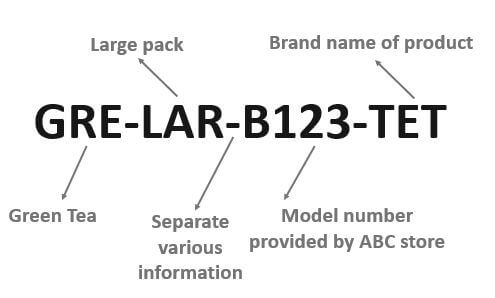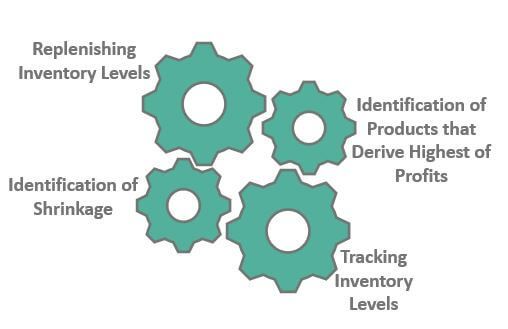Table Of Contents
Full Form of SKU - Stock Keeping Unit
The full form of the SKU is Stock Keeping Unit. It is the barcode printed on the different product labels for ease of inventory tracking and its management, identifying a particular product, and reconciliation of stock levels of each product. Moreover, analyzing the most profitable products, identifying reorder points, and saving customers time, ensures one can find the desired products easily and conveniently.

How Does it Work?
An SKU comprises numbers and letters. One may use this alpha-numeric combination to describe a product's details concerning its color, brand name, model number, and so on. Every company has a unique way of creating stock keeping units for their goods, and the following are the aspects that must be taken into due consideration while generating an SKU:
- One must ensure that every SKU is unique and not reused. In other words, one must ensure that each product allots a unique SKU.
- Stock Keeping Unit must be kept short and simple. Keeping a long SKU can be quite complicated for the readers and sometimes fail to work in an inventory management system.
- One must always avoid using space and special characters as they can confuse the readers.
- Alphabets that can be confused with numbers must not take into use. One must avoid alphabets like O, I, and J as these can be confused as 0 and 1.
Example of SKU
Let's take an example.

ABC store sells tea of different varieties and different companies. The store started to deal with Tetley green tea recently. The store created an SKU for a large packet of Tetley green tea as GRE-LAR-B123-TET.
Where,
- GRE stands for Green Tea
- LAR stands for Large pack
- B123 is the model number provided by the ABC store
- Dash (-) is used to separate various information about green tea
- TET dictates the product's brand name, i.e., Tetley.
The Stock Keeping Unit determined that a large pack of Tetley green tea is simple, short, unique, and easily understandable by the readers. At the same time provides all the valuable information concerning the product.
Uses
The uses of the Stock Keeping Unit are as follows:

- Tracking Inventory Levels: It enables the users to easily track their inventories and find out the availability and even the total quantity of a specific product. As a result, it helps users save time and prevent stock out since they can easily identify the products they must reorder.
- Identification of Shrinkage: One may even use these to track and identify inventory shrinkage, i.e., the total number of missing items that a company cannot sell.
- Identification of Products that Derive Highest of Profits: One can even use it for tracking products that are the best selling and products that are not performing or underperforming. It allows the stores to focus more on products that are best selling and less or rather eliminate products that are not best selling or underperforming.
- Replenishing Inventory Levels: One can use Stock Keeping Unit to replenish inventory levels, i.e., to identify reorder points for each product and eliminate the possibility of stock-out.
Importance
The Stock Keeping Unit is crucial and widely used by warehouses and retail shops. The importance of SKUs is enumerated as follows:
- The Stock Keeping Unit helps customers compare similar products based on their characteristics such as prices, quantity, quality, manufacturing date, ingredients, etc.
- SKU helps in the collection of data during sales.
- It helps in the identification of a product.
- The Stock Keeping Unit eases the tracking of inventory, which is of great help for the users to find out the quantity of a particular item at the moment.
- SKU helps in detecting any inventory shrinkage.
- It helps in inventory management.
- SKU helps users to find out the reorder point for a specific product.
- Stock Keeping Unit helps in calculate the profitability of all the products.
- SKU helps in reconciling inventory levels of a specific product.
Stock Keeping Units vs Universal Product Codes
Stock Keeping Units and Universal Product Codes differ on various parameters. A Stock Keeping Unit differs from company to company. The companies generate Stock Keeping Units, and the construction mechanism differs for all companies. On the other hand, UPCs or Universal product codes are identical for all companies. Therefore, Stock Keeping Units are not the same for all companies, while Universal Product Codes are the same for all companies.
Benefits of SKU
- Stock Keeping Unit helps optimize the product catalog management of the users.
- SKUs help in tracking inventory levels.
- They are of great use in replenishing inventory levels. It is due to this reason that stores that have SKUs stock out rarely.
- Stock Keeping Unit can help in analyzing sales trends as well as levels.
- It helps identify the products that are the best performing, average performing, underperforming, or not performing at all.
- SKUs help in the application of customer behavior analytics.
- Stock Keeping Unit helps enhance productivity and improve inventory flexibility per the demand of a specific product.
Conclusion
SKU is the abbreviation used for Stock Keeping Units. It is a scannable barcode that helps storekeepers or vendors track and manage inventory levels. It helps the users to identify the replenished products that need to be reordered and even offers sales data. Stock Keeping Unit enables the storekeepers to easily identify the quantity of a specific product and even help customers compare similar products. The construction mechanism differs from company to company and must not be confused with UPCs or Universal Product Codes.

